A recent article in Science, based on multiple indirect data sources and models, estimates that 3,941 cubic kilometers of the world’s soil moisture water were lost between 1979 and 2016. That is an enormous amount of water. Lake Huron holds 3,500 cubic kilometers, while Lake Michigan holds 4,918 cubic kilometers.
Unless you are a soil microbe, springtail, worm, or robin foraging for worms, soil moisture likely isn’t at the top of your list of concerns, even if you are very worried about climate change. The distinction between dirt and soil is that soil is alive and can retain moisture. The difference between flour and bread is life; yeast consumes flour, contributing to the texture of bread.
The Wonder Bread of my youth once claimed to build bodies eight ways, with protein, calcium, phosphorus, iron, Vitamin B1, Vitamin B2, Niacin, and energy. Flowers Food, the company that makes Wonder Bread, increased their claims in 1971 to 12 ways. However, the Federal Trade Commission compelled them to scale back their promises.
Soil also builds bodies (fungi, microbes, mites, tardigrades, and all) with nutrients prepared for consumption by bacteria and energy supplied by plants, which photosynthesize carbon dioxide and water into carbohydrates. A plant repairs itself when cut or chewed, producing more plant fiber and carbohydrates pushed out of roots as exudate to nourish fungi and the soil.
Add water to dirt or flour, and you’ll get a sticky mess. Soil holds moisture, much like sliced bread, which will hold a liquid egg to become French Toast and still make room to soak up maple syrup. Four inches deep, healthy soil acts as a carbon sponge, holding seven inches of rainwater.
Baked To A Hard Crust
The problem with soil begins at the crust. If it becomes excessively crusty, the soil surface will be unable to accept or retain water. We contribute to the hardening of the surface through heavy tillage, the use of fertilizers that harm microbes, repeated fires, drainage, the destruction of wetlands, deforestation, loss of biodiversity, erosion, unmanaged grazing, and all their combinations.
We’ve deprived the world’s soil and the lives within more than a Lake Huron volume of life-giving moisture, and that’s just the beginning of the troubles ahead. When the land dries, plants lose the ability to release water vapor that evaporates to cool or condense, which warms with the morning dew. With plant evapotranspiration greatly reduced, the hundreds of horsepower per acre of solar power that would normally cycle water is re-routed to warming and baking the earth. The rising hot air draws in more drying winds. Cumulus cloud formation ceases, except for fiercer afternoon thunderstorms.
Raindrops unable to penetrate the soil join to form rivulets that gather speed and converge to become streams, transporting sediments that scour the land. Erosion carves, sedimentation smothers, and floodwaters rise, bringing more destruction.
The clouds have silver linings because the annual rainfall amounts have remained relatively unchanged. When it rains, and water is plentiful, we need to slow it down and return it to the soil or ground, where it will be when needed during dry weather to recharge rivers. We should give the ground natural rights to retain its rainwater. Instead of stormwater, the rainwater should be channeled into the ground through rain gardens, pumps, cisterns, and French drains whenever a developer transforms vegetation and soil into constructions of cement and steel.
From Baked To Flooded
The loss of green vegetation and soils from the landscape resembles the emperor with no clothes. We are so enamored with our constructions and artificial creations that we fail to see the naked truth. For example, Boston receives an average of 43.6 inches of rain every year. The rains come in stronger bursts, yet the annual volume remains consistent. The damage does not originate from the sky but from stormwater flooding communities. Tidal dams are constructed to keep out the rising seas, thereby preventing stormwater from the land from reaching the sea and causing further flood damage. Therefore, during the dry summer heat, it is no surprise that the land becomes so dry that forest fires ravage once-wet areas, such as the red-maple swamps in Middleton – the landscape gets no water.
Developers profit while municipalities manage the water from off their properties at great expense to the community. Developers must be held accountable for the land’s hydrology and not be permitted to flush stormwater away to water works that most municipalities cannot afford to manage, leaving residents in low-lying areas of town standing in combined sewage overflow.
Let’s put the rainwater back into the soil to replenish life in the rhizosphere. The figure of 3,941 cubic kilometers represents a significant amount of water lost from the world’s soils. By allowing (and encouraging) rainwater to infiltrate the ground where it falls, we can reduce stormwater damage, combat climate change, and decrease sea level rise by as much as 25 percent (10 mm). More water in the soil will result in healthier soils, enable plants to photosynthesize for more extended periods, provide additional shade in hot weather, and make our neighborhood’s climate more comfortable with increased life throughout the year.
About the Author
Dr. Rob Moir is a nationally recognized and award-winning environmentalist. He is the president and executive director of the Ocean River Institute, a nonprofit based in Cambridge, MA, that provides expertise, services, resources, and information not readily available on a localized level to support the efforts of environmental organizations. Please visit www.oceanriver.org for more information.
Source link
Earth911 earth911.com


